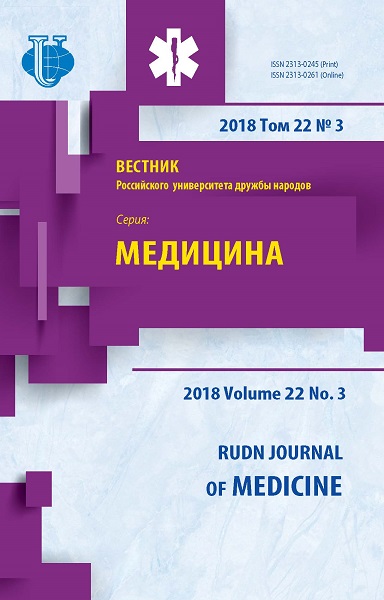THE CHOICE OF IMPLANT FOR HERNIOPLASTY OF POSTOPERATIVE VENTRAL HERNIAS
- Authors: Protasov AV1, Kalyakanova IO1, Kaitova ZS1
-
Affiliations:
- RUDN University
- Issue: Vol 22, No 3 (2018)
- Pages: 258-264
- Section: SURGERY. ANDROLOGY
- URL: https://journals.rudn.ru/medicine/article/view/19670
- DOI: https://doi.org/10.22363/2313-0245-2018-22-3-258-264
Cite item
Full Text
Abstract
According to the literature, up to 50% of laparotomies end with herniation. Therefore, postoperative ventral hernias will not lose their relevance for a long time. The appearance of non-tension hernioplasty by means with synthetic implants helped to solve some issues of hernia: the frequency of relapses in the late postoperative period significantly decreased. However, the number of the complications associated with suppuration of postoperative wounds and seroma in the early postoperative period increased. This leads in the increase of number days of hospital treatment, the need for antibiotic therapy, and accordingly the cost of treatment. In this regard, new types of implants that have the necessary biocompatibility properties are constantly being developed. Also, implants with the possibility of self-griping to the tissues have become more and more relevant in recent years. Self-gripping implants are not only convenient for the operating surgeon - reducing the time of operation, but also don’t cause of the chronic pain in the area of operation. However, the problem of surgical treatment of postoperative ventral hernias remains unresolved. The aim of study was to improve the quality of life of patients with postoperative ventral hernias. Was surgery with implants ProgripTM 65 patients. Patients were divided into two groups, taking into account the use of standard implant shape and simulated. The frequencies of surgical complications, duration of surgery and inpatient treatment were compared. The relapse developed in 14.7% and 3.2% of cases, respectively. There were no other significant complications. Conclusion: the simulated implant is anatomically correct and reduces the risk of detachment of the implant from the tissue during stretching.
About the authors
A V Protasov
RUDN University
Author for correspondence.
Email: paramonova-irina91@mail.ru
I O Kalyakanova
RUDN University
Email: paramonova-irina91@mail.ru
Z S Kaitova
RUDN University
Email: paramonova-irina91@mail.ru
References
- Gorskij V.А., Sivkov А.S., Polivoda M.D., Volenko А.V., Titkov B.E., KHachatryan G.V. et al. The method of collagen plate application for ventral hernias. Prakticheskaya meditsina. 2016. № 5 (97). P. 67—72.
- Poulose B.K., Shelton J., Phillips S., Moore D., Nealon W., Penson D. et al. Epidemiology and cost of ventral hernia repair: making the case for hernia research. Hernia. 2012. № 2. P. 179—183. https://doi.org/10.1007/s10029-011-0879-9.
- Williams D.F. On the mechanisms of biocompatibility. Biomaterials. 2008. № 29 (20). P. 2941—2953. https://doi.org/10.1016/j.biomaterials.2008.04.023.
- Procter L., Falco E.E., Fisher J.P., Roth J.S. Abdominal wall hernias and biomaterials: Bioengineering research of chronic wounds. 1st ed. Berlin Heidelberg: Springer Verlag, 2009. P. 425—447. https://doi.org/10.1007/978-3-642-00534-3_19.
- Vinnik YU.S. CHajkin А.А., Nazar'yants YU.А., Petrushko S.I., SHishatskaya E.I., Markelova N.M. et al. Application of polyhydroxyalcanoates in laparoscopic intraperitonealonlay mesh for postoperative abdominal wall repair in patients with hernias. Endoskopicheskaya khirurgiya. 2015. № 4. P. 3—6. https://doi.org/10.17116/ endoskop20152143-6.
- Bachman S., Ramshaw B. Prosthetic material in ventral hernia repair: how do I choose? Surgery Clinic. 2008. Vol. 88. P. 101—112. https://doi.org/10.1016/j.suc. 2007.11.001.
- Bilsel Y., Abci I. The search for ideal hernia repair; mesh materials and types. International Journal of Surgery. 2012. № 10 (6). P. 317—321. https://doi.org/10.1016/ j.ijsu.2012.05.002.
- Sridharan R., Cameron A.R., Kelly D.J, Kearney C.J., O’Brien F.J. Biomaterial based modulation of macrophage polarization: a review and suggested design principles. Materials Today. 2015. № 18 (6). P. 313—325. https://doi.org/10.1016/j.mattod.2015.01.019.
- Bringman S., Conze J., Cuccurullo D., Deprest J., Junge K., Klosterhalfen B. et all. Hernia repair: the search for ideal meshes. Hernia. 2010. № 14 (1). P. 81—87. https://doi.org/ 10.1007/s10029-009-0587-x.
- Аlishev O.T., SHajmardanov R.SH. The current situation and problems in treatment of large postoperative ventral hernias. Prakticheskaya meditsina. 2013. № 2 (67). P. 16—21.
- Cavallo J.A., Greco S.C., Liu J., Frisella M.M., Deeken C.R., Matthews B.D. Remodeling characteristics and biomechanical properties of a crosslinked versus a non-crosslinked porcine dermis scaffolds in a porcine model of ventral hernia repair. Hernia. 2015. № 19 (2). P. 207—218. https://doi.org/10.1007/s10029-013-1070-2.
- Petro C.C., Nahabet E.H., Criss C.N., Orenstein S.B., Recum H.A., Novitsky Y.W. et al. Central failures of lightweight monofilament polyester mesh causing hernia recurrence: a cautionary note. Hernia. 2015. № 19 (1). P. 155—159. https://doi.org/10.1007/s10029-014-1237-5.
- Vorst A.L., Kaoutzanis C., Carbonell A.M., Franz M.G. Evolution and advances in laparoscopic ventral and incisional hernia repair. World Journal Gastrointestinal Surgery. 2015. №7 (11). P. 293—305 https://doi.org/ 10.4240/wjgs.v7.i11.293.
- Zuvela M., Galun, D., Djuric-Stefanovic A., Palibrk I., Petrovic M., Milicevic M. Central rupture and bulging of low-weight polypropylene mesh following recurrent incisional sublay hernioplasty. Hernia. 2014. № 18 (1). P. 135—140. https://doi.org/10.1007/s10029-013-1197-1.
- Privett B.J., Ghusn M. Proposed technique for open repair of a small umbilical hernia and rectus divarication with self-gripping mesh. Hernia. 2016. № 20 (4). P. 527—530. https://doi.org/10.1007/s10029-016-1470-1.
- Eriksen J.R., Bisgaard T., Assaadzadeh S., Jorgensen L.N., Rosenberg J. Fibrin sealant for mesh fixation in laparoscopic umbilical hernia repair: 1-year results of a randomized controlled double-blinded study. Hernia. 2013. № 17. P. 511—514. https://doi.org/10.1007/s10029-013-1101-z.
- Morales-Conde S., Suárez-Artacho G., Socas M., Barranco A. Influence of fibrin sealant in preventing postoperative seroma and normalizing the abdominal wall after laparoscopic repair of ventral hernia. Surgery Endoscopic. 2013. № 27. P. 3214—3219. https://doi.org/ 10.1007/s00464-013-2894-7.
- Bueno-Lledó J., Torregros A., Arguelles B., Carre O., García P., Bonafé S., Iserte J. Progrip self-gripping mesh in Rives-Stoppa repair: Are there any differences in outcomes versus a retromuscular polypropylene mesh fixed with sutures? A “case series” study. International Journal of Surgery Case Reports. 2017. № 34. P. 60—64. https://doi.org/10.1016/j.ijscr.2017.03.012.
- Hopson S.B., Miller L.E. Open ventral hernia repair using ProGrip self-gripping mesh. International Journal of Surgery. 2015. № 23 (Pt A). P. 137—40.
















